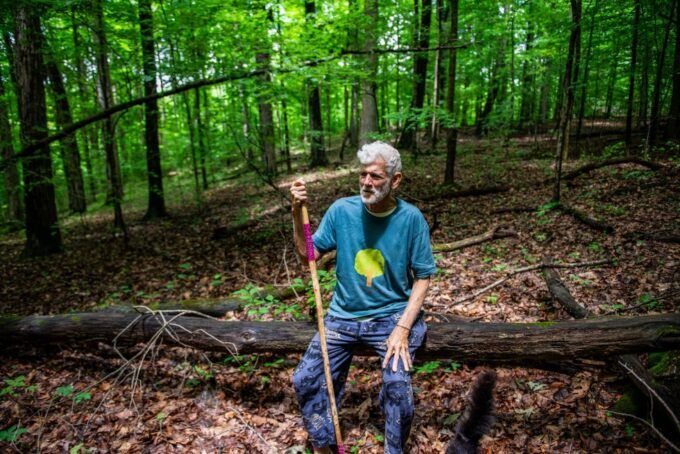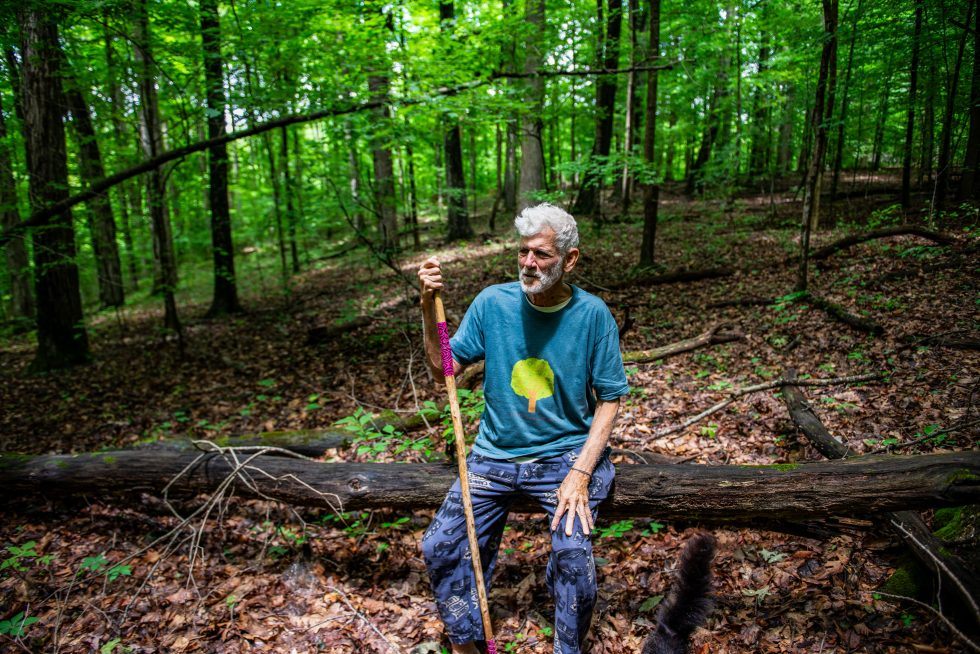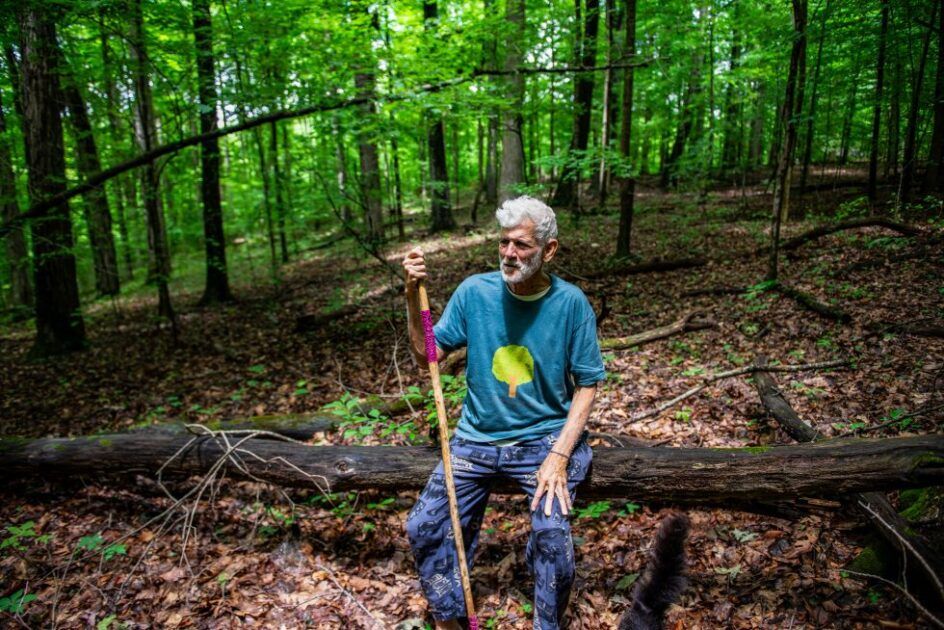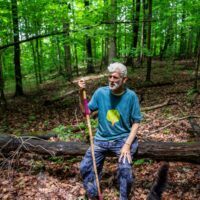Before I begin relating my four-decade tale about Andy Mahler and Me, I want to share an observation from my granddaughter Raina, which I know you all will intuitively appreciate.
A month before he passed, I brought her and her brother Vale down to the Lazy Black Bear, I guess, to say goodbye. A few months before that, Rain had spent an afternoon exploring this hidden fantasyland in the woods with her bff Ayturk, while Andy and I talked. As we were leaving that last time, she proclaimed with an unforgettable smile on her face:
“This is the most magical place I’ve ever been.”
Raina and Vale, Lazy Black Bear, July 2025
We’re all here because of our experiences with Andy Mahler. I’m going to share the one that led he and I to this book collaboration, a journey that began in 1985 and ended at his bedside just hours before he passed.
But I want to cut to the jump here and say something about Andy the man.
I’m a journalist. I’ve spent the past 45 years seeking out the most compelling people I could find so I could tell their stories.
By the time I left the Bloomington Herald-Times in 1996, I had written 2,000 to 3,000 byline stories. So the number of charismatic, dynamic, magnetic, brilliant, talented, powerful, influential people I’ve known likewise numbers in the thousands.
Andy is the only one that I wrote an entire book about.
Andy and I were born two months apart in 1951, but aside from tracing our love of trees to climbing them as kids, we couldn’t have been any different.
Grandpa Mahler hailed from Vienna. Grandpa Higgs hailed from Little Rock.
Andy spent his childhood on the professor-class east side of Bloomington. I spent mine on the working-class east side of Indianapolis.
Andy summered on Cape Cod, visited family in Manhattan, and spent a year each living in Paris and Sao Paolo. I summered on East 18th, and aside from one trip to Florida I can barely remember, Moline, Ill., was as far as I ever ventured.
Andy was charismatic, dynamic, magnetic, brilliant, talented, powerful, and influential. He also had movie star good lucks.
Me, well, not so much.
I knew from the times we spent hanging, walking, and talking that Andy was the most remarkable human being I had ever encountered.
What I didn’t know about until this book was his equally remarkable family life. It’s all there in the book, so I’ll just hit a couple highlights here.
Andy grew up in Bloomington as a first-generation American, with no idea how to play that role. His parents escaped Hitler’s Vienna in 1938. Each came to America alone as teenagers; father Henry was 17, mother Annemarie just 13.
Henry worked with Nobel Laureates and, had he not died at 62, may have earned the world’s most prestigious scientific honor for his work that earned him the nickname Mr. Mitochondria.
Henry Mahler
My path to Andy Mahler and the Hoosier National began 50 years ago last May, when I moved to the woods by Lake Monroe and discovered photographer Eliot Porter’s In Wildness is the Preservation of the World.
I would later learn that In Wildness was the first coffee table book ever published. And since the moment Porter’s images stole my breath in the IU Fine Arts library, I’ve been working on this, my first coffee table book.
Indeed, I captured the first three images in Andy Mahler and the Hoosier National in 1975.
The shack where I lived and discovered Porter’s color photography sat on a forested ridgetop overlooking Lake Monroe. From my kitchen window, I could see the Hoosier’s wild and rugged Miller Ridge due east in Brown County.
A 20-minute drive down Knight Ridge Road passed one of the northernmost Hoosier National welcome signs.
From that Depression-era, five-room hovel – tin roof; no insulation; a single, oil-burning space heater in one room – I spent three years hiking and photographing the Hoosier, from Pate Hollow to what is now the Deam Wilderness.

Knight Ridge Road Shack, September 1974.
After we moved to an apartment in the city in 1980 and I went stir crazy, my wife Judy told me I needed to go to a Sierra Club meeting or something.
I did. And that meeting of the Uplands Group of the Sierra Club set me down the path to Andy Mahler and the Hoosier National.
That night at the Monroe County Library, I encountered a college kid named Jeff Stant, who spoke passionately about the fight to establish a federally protected Wilderness Area on the Hoosier.
Jeff recruited me to be the group’s newsletter editor, after which I decided to become a journalist and entered the Masters Program at the IU School of Journalism, which is how I met Andy.
Toward the end of my studies, the Forest Service announced plans to clearcut 81% of forest in 30-acre blocks, and to put ORV trails down in Orange County and up my way in Brown County.
That’s what got Andy and I both involved in Hoosier National politics and formed the basis of our 40-year personal and professional relationships.

As our book explains, in 1985, Andy and wife and life partner Linda Lee, Bob and Kathy Klawitter, and their neighbors formed the seminal forest protection group Protect Our Woods to fight the ORV and clearcutting plans.
That same year, I took a job as an environmental writer at The Bloomington Herald-Times, as I finished my final masters project: Clearcutting the Hoosier National Forest: Professional Forestry or Panacea?
That project became my first Sunday Centerpiece in the H-T, and it prominently featured Andy Mahler, alongside Stant from the Hoosier Environmental Council, Jeffrey St. Clair from Brown County’s ForestWatch, and Bob Klawitter from Protect Our Woods.
My first trip to the Lazy Black Bear was with Stant, St. Clair, and Denise Joines.
Talk about a profound, magical experience.
Within seven years of our first day together at the Lazy Black Bear, Andy and Co. had achieved remarkable, unprecedented success in their efforts to save their beloved Hoosier National.
Because of their activism:
The Hoosier became the first national forest in the country to permanently ban off-road vehicles. The very first.
The Forest Service withdrew the 1985 clearcutting plan entirely.
Every Indiana Senator and Congressman, save one Republican banker, sent a letter to the Forest Service saying they wanted the Hoosier National managed Andy’s way.
A poll commissioned by Congressman Frank McCloskey found 70% of his constituents opposed any logging on the Hoosier National.
The Forest Service ultimately adopted the Conservationists Alternative, which was written by St. Clair through a grant from Stant and the Hoosier Environmental Council.
While it’s been weakened and despoiled by the Forest Service over the past 33 years, the Conservationists Alternative remains the framework under which the Hoosier National is managed.
The Conservationists Alternative is the reason the woods surrounding the Lazy Black Bear tonight wasn’t clearcut 40 years ago.
As Andy told me for the book, Hoosier activists instinctively knew that practically eliminating logging on their national forest would increase pressure on others nearby. So in January 1991, Heartwood formed right here at the Lazy Black Bear, adopting an innovative, bioregional approach to forest protection to help activists in surrounding states confront that increased pressure to cut.
As POW had been at the state level in Indiana, Andy and Heartwood were in the forefront of a national, grassroots forest protection movement to compliment the efforts of national groups like the Wilderness Society and Sierra Club, which were focused on Alaska and the great forests of the West.
And they were just as successful as POW, ForestWatch, and HEC had been. They effectively shut down logging on millions of acres of national forests from Missouri to Pennsylvania to Alabama for extended periods of time.
As we note in the book, Heartwood-inspired activism shut down logging on Illinois’s Shawnee National Forest for 17 years.
Also for the book, Andy told me that, following the Heartwood success, he had been comfortably retired from activism for 20 years when he heard about Buffalo Springs in 2021, which I knew wasn’t totally true.
I used to listen to him on WFHB, where he hosted a cutting-edge public affairs interview program called Interchange. He served on the board of directors for Bloomingfoods and was instrumental in establishing the Lost River Coop & Deli in Paoli.
In the inaugural print edition of The Bloomington Alternative in 2005, I featured a front-page photo of Andy leading a meeting between activists and Forest Service officials.
Through the Alternative, I hosted a panel discussion in City Hall on state forest management that featured Andy and then-DNR Director and future Indiana Republican Party Chair Kyle Hupfer.
Still, I hadn’t seen or talked to Andy much when I learned in April 2024 that he had untreatable, Stage 4 cancer and asked if he’d be interested in talking about this sad news.
Nine months later, when I proposed we collaborate on the book, he instantly agreed, saying: “We have both been preparing for it our entire professional lives.”
From Day 1, Andy and I agreed on three things.
1/ Even if the book turned out to be a vanity project, it would be worth it for the time we spent together.
2/ Our primary purpose was to spread Andy’s message and story after he was gone.
3/ We would use any proceeds beyond basic costs and compensation for my time to support groups that fight for the forest and other worthy causes, like Heartwood and Protect Our Woods.
In June 2024, Andy, his little dog Wagner, and I walked through the woods surrounding the Lazy Bear and talked about his diagnosis and imminent demise. That turned into Metaphor of the Cicadas, a piece published by St. Clair in CounterPunch and the first chapter of our book.
“Every second is an opportunity for extraordinary depth and fulfillment of purpose,” he told me that afternoon.
Over the next 15 months, we corresponded regularly. I spent nine days talking with or watching him lead protests and play music.
I’m almost positive I took Andy for his last walk in the woods on July 7, when I brought Limestone Postwriter Anne Kibbler down for a tour of Buffalo Springs and an article she wrote titled Andy Mahler: Folk Hero of the Forest. All he could manage was a short walk from a backcountry road to a pioneer cemetery.
Andy had just started having pain, and we dropped him off at the doctor on our way out of town. Ten days later he texted to say he was in Bloomington Hospital. He entered Hospice that day.
I never let myself accept the reality that Andy’s time was about up, but I knew the day would come when I would spend my time with him at his bedside. That eventuality materialized on my visit with Raina and Vale on July 26, when we just talked.
Andy said that day he wanted to live long enough to hold our book in his hands. Three weeks later, I shot my next-to-last photo of Andy holding the full, first draft of the book, his radiant smile and cover image filling the frame.
My Buddhist friend Michael accompanied me that day, as Andy and I talked about the people he worked with his entire career. He burst into tears when Michael presented him with a Tibetan scarf called a khata that had been blessed by the Dalai Lama.
Linda Lee, Andy Mahler.
Four decades after I interviewed Andy for the first time, nine days before he passed, I recorded him for the last time. Fittingly, the subject was Linda, Andy’s life love and inspiration.
I shot my last photo of Andy during that visit, and visitor Tamara Lowenthal took the only photo of Andy and I together that exists.
His last words to me that day, as we ended our final hug: “I love you brother.”
When a mutual friend messaged me that Andy had stopped responding and his prognosis was gloomy, I drove down to say goodbye on Aug. 29. I got home at 5 p.m. Kathy Klawitter told me the next morning that Andy passed.
I wasn’t feeling particularly creative that day, and when his caretakers Paul, Maggie, Kare, and Brad left us alone for a few minutes, I echoed Andy’s words back to him.
“I love you, too, brother.”
All photos by Steven Higgs.
Higgs’ book, Andy Mahler and the Hoosier National: The Folk Hero and the Forest He Loves, can be purchased here.
The post Andy Mahler and Me appeared first on CounterPunch.org.
From CounterPunch.org via this RSS feed






















